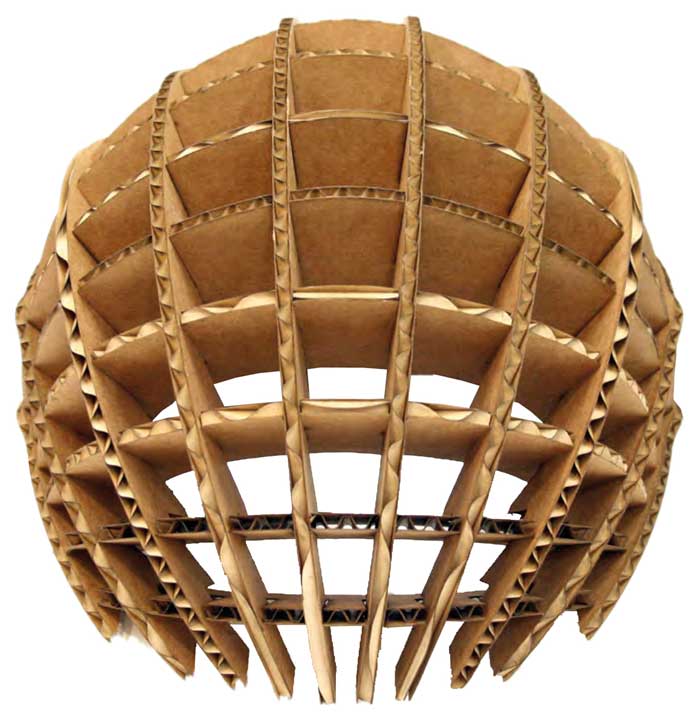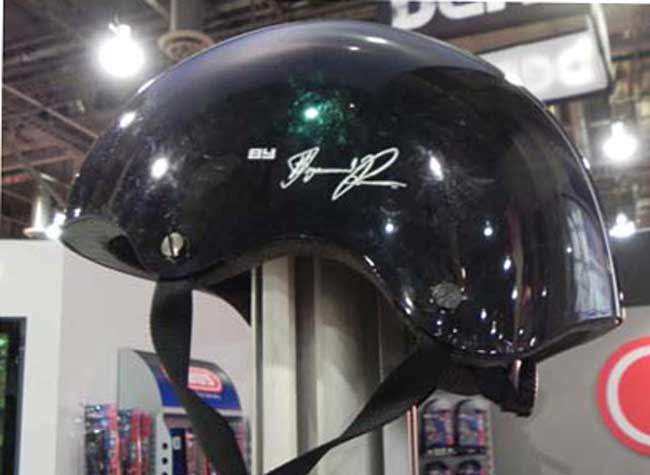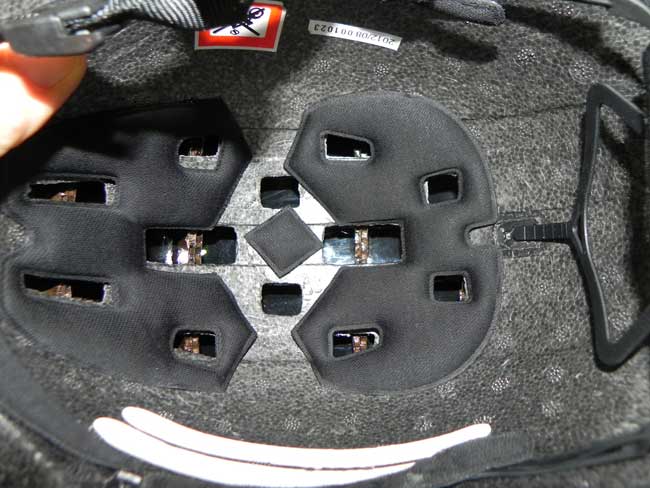Helmets.org
Bicycle Helmet Safety Institute
Consumer-funded, volunteer staff
| Helmets | Children | Promotions | Statistics | Search |
The Kranium Helmet
Summary: We considered the Kranium "cardboard helmet" design unproven back when it was first introduced, but it would have been an advance toward a really recyclable helmet, and the inventor said it could be customized for head shape, a real advantage. Perhaps the design will surface again some day.
At the London Cycle Show in 2011 inventor Anirudha Surabhi introduced a prototype of a radical new helmet design. The Kranium had a shell like a conventional hard shell skate style helmet, but instead of a conventional foam liner it had interlocking rows of corrugated material that look like cardboard.
 Despite what you may read in blogs, the Kranium
was not made from "the same cardboard you find in boxes at the supermarket." Helmet standards require testing a sample
after four hours of submersion in water, so the inventor said the material was coated to be waterproof and could survive
seven days of submersion.
Despite what you may read in blogs, the Kranium
was not made from "the same cardboard you find in boxes at the supermarket." Helmet standards require testing a sample
after four hours of submersion in water, so the inventor said the material was coated to be waterproof and could survive
seven days of submersion.The Kranium liner was made of a paper-based material, but the shell was normal plastic made of petroleum raw material. It might have had the advantage of being recyclable. Foam helmets are not, and are an ecological disaster, because EPS will last for centuries in a landfill. But since the corrugated material in the Kranium could not be cardboard because users must be able to ride in the rain with it, the liner had to be made with corrugated plastic or cardboard material impregnated with a polymer of some kind, and that would probably render it non-recyclable. In addition, the only helmet that ever appeared on the market with the Kranium honeycomb liner also had an EPS liner.
The Kranium's inventor said it can be custom made, fitted to each head. That would be a boon to those with odd head shapes, and a big advantage for people with very large heads who still can't find helmets. But as skiers discovered with custom-foamed ski boots, the service to perform the custom fitting work is always much more expensive than the materials. EPS is nearly as cheap as cardboard anyway. And it would be difficult to certify a custom helmet to a standard, since the certification process requires testing different production samples under ambient, hot, cold and wet conditions. Users could just snip away at the liner as they do with EPS, but the result might be a dangerously underperforming helmet, with no way to know that until a crash.
There is considerable assembly required to put a helmet liner together with the corrugated pieces, perhaps raising the final price above a conventional foam helmet. The assembly might take 20 minutes and involved handling many parts. Quality control would be difficult to assure compared to foam. And explaining to a jury why your "cardboard" helmet did not prevent a head injury could be a problem for manufacturers.
The designer understood that shared bicycle programs have a helmet problem, and says the Kranium could be dispensed from vending machines. But a conventional foam helmet can be too, and custom fitting would not be practical in a vending machine.
The first implementation of the design was shown at a fall, 2012 bicycle industry trade shows by Abus, a German manufacturer. It was called the Kranium Ecolution, but was renamed the Performance. It was a hybrid design, with one layer of corrugated material strips next to the hard shell and one layer of regular EPS foam between that and the head. Abus said the EPS foam was recycled. The Performance retailed for 80 pounds in the UK.

 The photo above
shows the two layers of the Performance's liner. Through the vents you can see the corrugated material forming the layer
between the shell and the standard EPS liner.
The photo above
shows the two layers of the Performance's liner. Through the vents you can see the corrugated material forming the layer
between the shell and the standard EPS liner.More info and videos
The inventor produced a very interesting technical paper that includes standard lab test results to a portion of the European helmet standard. The results are only for an ambient helmet and only on the flat anvil, testing the top (where virtually nobody hits) and two spots on the right and left front corners. The top results are impressive, but the sides are very little better than helmets with an all-EPS liner. We think the angle of impact might have a big effect on the cardboard's ability to perform due to the alignment of the cardboard strips. But that might help tame rotational force. The inventor said his liner is designed to flex in some locations and be stiff in others until the crush begins. There is no multi-impact data. Here is a very interesting video explaining how the inventor's thought process worked, showing the assembly steps and presenting the claims for the Kranium's performance.
All in all, the Kranium deserves high marks as a design project that came at the problem from a completely different angle, but we don't think you are likely to see a helmet brought to market with that design. The version Abus marketed was a hybrid using EPS, and not designed to meet the US standard. The EPS is needed to keep the edges of the cardboard from sawing on the rider's head.
Other alternatives to foam are already performing in some football helmets and the Seven System in Cascade's lacrosse helmets. They are using plastic forms that deform at a controlled rate in a crash to replace the EPS entirely. Like the Kranium, they perform well at lower impacts, but they don't meet US bicycle helmet impact standards. And the newer HEXR and KAV additive manufacturing designs that are 3D printed use other materials, including in the HEXR case Caster Oil. We have more on our page on helmet liners.